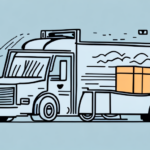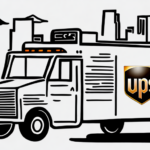How to Pack a Large Box for UPS Shipping
Shipping with UPS requires proper packing to ensure that your package arrives at its destination safely and without damage. In this article, we will cover everything you need to know about how to pack a large box for UPS shipping.
Why Proper Packing is Important When Shipping with UPS
Properly packing your items for shipping with UPS is crucial for several reasons:
- Protection from Damage: Ensures your items remain intact during transit.
- Compliance with UPS Requirements: Prevents delays or additional fees by adhering to UPS’s guidelines.
- Enhanced Tracking: Makes it easier to identify and monitor your package’s progress.
- Prevention of Theft or Tampering: Sturdy boxes and clear labeling deter potential theft.
- Environmental Impact: Using recyclable materials and appropriately sized boxes reduces waste and shipping costs.
According to UPS, proper packaging can reduce shipping damages by up to 50%, highlighting the importance of investing time in packing correctly (UPS Packaging Guidelines).
Understanding UPS Shipping Requirements
Before packing your items, it's essential to familiarize yourself with UPS's shipping requirements, which vary based on destination and item type:
- Box Size and Weight Limits: UPS has specific dimensions and weight restrictions. For example, the maximum weight for a single package is typically 150 lbs, and the maximum length is 108 inches (UPS Shipping Services).
- Packaging Materials: Use sturdy, new corrugated boxes and ensure all seams are securely taped.
- Labeling: Clearly label your package with both sender and recipient information.
UPS offers various shipping options to meet your needs, including:
- UPS Ground: Cost-effective for domestic shipments.
- UPS Air: Faster delivery for urgent shipments.
- International Shipping: Requires understanding of customs regulations and additional fees.
Choosing the Right Box Size and Material for Your Shipment
Selecting the appropriate box size and material is vital for the safety and efficiency of your shipment:
- Box Size: Choose a box that accommodates your items without excessive empty space. This minimizes movement and potential damage.
- Box Material: Use double-walled boxes for heavy items or fragile contents. Cardboard is standard, but reinforced boxes offer added protection.
- Cushioning: Invest in quality cushioning materials like bubble wrap or packing peanuts to fill any voids.
For heavy items, consider using a double-walled box or one with reinforced corners to provide extra support. Ensure that the box can withstand the weight without compromising its integrity.
Using Protective Materials to Secure Your Items
Protective materials are essential to secure your items within the box and prevent movement during transit:
- Bubble Wrap: Ideal for wrapping delicate items to cushion against impacts.
- Packing Peanuts: Fill empty spaces to prevent items from shifting.
- Air Pillows: Lightweight and effective for providing an additional layer of protection.
- Foam Inserts: Offer durable protection for high-value or fragile items.
Ensure that all protective materials are securely placed and that there is no excessive movement within the box. Properly securing these materials can significantly reduce the risk of damage.
How to Wrap and Cushion Fragile Items for Safe Transport
When shipping fragile items, extra care is necessary to ensure they arrive safely:
- Multiple Layers of Protection: Wrap items in several layers of bubble wrap or packing paper.
- Use of Foam Inserts: Place foam inserts around the items to absorb shocks.
- Appropriate Box Size: Use a box slightly larger than the item to allow space for cushioning materials.
- Label as Fragile: Clearly mark the package to alert handlers to handle with care.
Sealing the box securely with high-quality packing tape ensures that it remains closed during transit. Properly cushioned fragile items can prevent breakage and damage.
Tips for Organizing and Arranging Items in Your Box
Effective organization and arrangement within the box maximize space and enhance protection:
- Stacking Strategically: Place heavier items at the bottom and lighter items on top.
- Side-by-Side Placement: Arrange items side-by-side to create a compact and stable package.
- Avoid Overpacking: Overpacking can lead to increased shipping costs and potential damage to items.
- Use of Packing Materials: Incorporate bubble wrap, packing peanuts, or foam inserts to secure items.
Labeling the box with contents and special handling instructions ensures proper treatment during shipping and helps prevent mishandling.
Securing the Box with Tape and Labels for Easy Identification
Properly securing and labeling your box is essential for safe and efficient delivery:
- Sealing the Box: Use strong packing tape to seal all edges and reinforce corners.
- Clear Labeling: Include both sender and recipient addresses, and any special handling instructions.
- Tracking Labels: Attach a shipping label or barcode for easy tracking during transit.
- Reinforced Tape for Heavy Packages: Use double layers of tape or reinforced tape for heavier packages to prevent the box from breaking open.
- Contact Information: Include a contact phone number in case there are issues with delivery.
Using clear and legible labels ensures that your package is handled correctly and can be easily tracked throughout its journey.
How to Measure and Weigh Your Package for Accurate Shipping Rates
Accurately measuring and weighing your package is crucial for determining the correct shipping rates and avoiding unexpected fees:
- Measuring Dimensions: Measure the length, width, and height of your box and calculate the total volume.
- Weighing Your Package: Use a reliable scale to determine the weight of the box and its contents.
- Understanding UPS Pricing: UPS uses both dimensional and actual weight to calculate shipping costs. Ensure you understand which is greater to avoid overpaying.
- International Shipping Considerations: Be aware of customs regulations and additional fees that may apply.
For detailed information, refer to the UPS Packaging and Supplies page.
Understanding Insurance Options for UPS Shipments
Protecting your shipment with insurance is an important consideration when shipping valuable or fragile items:
- Standard Liability: UPS includes basic liability coverage, but it may be limited.
- Declared Value: You can declare a higher value for your shipment for additional coverage.
- Restrictions: Certain items might have insurance limitations or require special handling.
- Filing Claims: In case of damage or loss, provide necessary documentation like receipts or proof of value promptly.
Review UPS's Insurance and Claims policies to understand your options and ensure adequate coverage.
How to Track Your Package Once It's Shipped
Tracking your UPS package helps you monitor its progress and ensures timely delivery:
- UPS Tracking Tool: Use the online tracking tool on the UPS website to get real-time updates.
- UPS My Choice: Sign up for notifications and manage delivery preferences through the UPS My Choice service.
- Mobile App: Download the UPS mobile app for on-the-go tracking and management.
- Multiple Package Tracking: The UPS tools allow you to track multiple shipments simultaneously.
For more tracking options, visit the UPS Tracking Services page.
Common Mistakes to Avoid When Packing a Large Box
Avoiding common packing mistakes can enhance the safety and efficiency of your shipment:
- Overpacking the Box: Avoid making the box too heavy, which can lead to damage and increased shipping costs.
- Insufficient Padding: Ensure there is enough cushioning to protect items from shocks and movements.
- Inadequate Sealing: Use strong packing tape to fully seal the box and reinforce edges.
- Poor Labeling: Clearly label your package with accurate addresses and handling instructions.
- Ignoring UPS Guidelines: Always adhere to UPS’s packaging and shipping requirements to prevent delays and additional fees.
By following these guidelines and avoiding common mistakes, you can ensure a safe and successful UPS shipment.
Additional Resources
For more detailed information on UPS shipping and packaging, visit the following reputable sources:






















